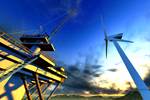NCC welcomes Scottish Renewables to SuSWIND steering board
Scotland’s renewable energy trade body joins several other members to guide and support technology advancement for recyclability and future wind blade development.
Share
Read Next
The National Composites Centre (NCC, Bristol, U.K.) announces that Scottish Renewables (Glasgow, Scotland) will be joining the SusWIND steering board. SusWIND is a collaborative innovation program focused on creating a viable circular economy for wind turbine blades. Launched in 2021 by the NCC, in partnership with the Offshore Renewable Energy (ORE) Catapult, the program focuses on working to accelerate the development of technology, processes and materials that address the recyclability and future development of composite wind turbine blades.
As Scotland’s renewable energy trade body, Scottish Renewables represents organizations working on a wide range of renewable energy technologies including onshore and offshore wind, hydropower, hydrogen, low-carbon heat, solar, tidal and wave energy.
“As an established, proven and critical part of the U.K. energy mix, sustainable wind offers an opportunity to increase U.K. energy security. Given Scottish Renewables’ leading role in the energy sector, collaborating with SusWIND for early supply chain intervention will accelerate the circularity of our renewable energy project pipeline,” Morag Watson, director of inshore for Scottish Renewables, says. “This will directly support the U.K. to meet net-zero targets while helping us seize growth opportunities across the globe.”
As a SusWIND steering board member, Scottish Renewables joins industry advisors including The Crown Estate, Crown Estate Scotland, BVG Associates, RenewableUK, ZeroWaste Scotland, Net Zero Technology Centre and Vestas. Collectively, the members provide strategic guidance to a growing community of stakeholders in the composites industry and energy sector that work toward creating end-of-life (EOL) value from past and current generations of turbine blades and embedding circularity principles at the heart of future generations of turbines.
Composite materials are a key enabler for the success of wind energy and the role it will play in delivering a low-carbon global economy. SusWIND brings together stakeholders from across the composites industry and wind energy sector to look at every aspect of the turbine product life cycle to achieve a sustainable future. Members drive and define the scope of work for wind turbine blade EOL to reduce impact and increase circularity, which in turn, feeds into other sectors dependent on large structures, be it aerospace, defense or space.
For more information on how to get involved in the SusWIND program, contact suswind@nccuk.com.
Related Content
-
Composites end markets: Energy (2024)
Composites are used widely in oil/gas, wind and other renewable energy applications. Despite market challenges, growth potential and innovation for composites continue.
-
Composites end markets: Batteries and fuel cells (2024)
As the number of battery and fuel cell electric vehicles (EVs) grows, so do the opportunities for composites in battery enclosures and components for fuel cells.
-
Hexagon Purus opens new U.S. facility to manufacture composite hydrogen tanks
CW attends the opening of Westminster, Maryland, site and shares the company’s history, vision and leading role in H2 storage systems.
















